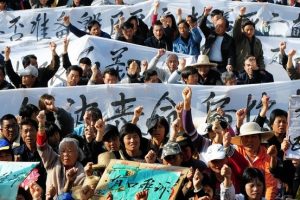Memo #150
By Sophia Woodman – sophia.woodman [at] ubc.ca
 Protests in China are often assumed to be ultimately aimed at regime change. But while protests reflect grievances, they also demonstrate faith that the state will respond to protesters’ demands.
Protests in China are often assumed to be ultimately aimed at regime change. But while protests reflect grievances, they also demonstrate faith that the state will respond to protesters’ demands.
Local authorities are directly responsible for the welfare and livelihood of the people in the area they govern. The central state makes its preference for local resolution of complaints abundantly clear: officials who do not prevent collective complaints originating in their areas from reaching higher levels face disciplinary consequences that can affect their careers. Human rights groups have documented how local authorities use illegal detention to punish petitioners who repeatedly take their complaints to higher levels. Yet, there are two practical reasons why such protests continue.
First, this sensitivity to protests gives people with grievances an incentive to use protest tactics. Second Brother, a Tianjin man crippled by childhood polio in one of the areas I studied, asserted his claim for housing by staging silent sit-ins in the foyer of the street office (街道办事处), the lowest level of formal government. He would ride his three-wheeler to the office and sit in the middle of the glass atrium chain-smoking and waiting for a response. This caused consternation among the staff of his local residents committee (居民委员会), as they were under pressure from their superiors to prevent such incidents. So, they had to persuade him to leave, and try address his request.
Second, because local officials have a great deal of discretionary authority, protests can achieve results. Even though the residents committee staff repeatedly explained to him that he was not eligible for housing, Second Brother knew local officials could find a solution to his problem if they chose. By the time I finished my fieldwork, nothing had been resolved.
Local protest followed by some accommodation can act to reaffirm the system. While oppositional dissent faces harsh state repression, not all protest is treated in this way. Some protests—perhaps many—are a routine feature of negotiations in local politics.
About the Author:
Sophia Woodman – postdoctoral fellow in the Faculty of Law and teaches sociology at The University of British Columbia.

Villagers holding banners and placards during a protest rally by residents of Wukan (Source: China Real Time Report)
Links:
- Local citizenship and socialized governance: linking citizens and the state in rural and urban Tianjin, China, The University of British Columbia, 2011. (By Sophia Woodman)
- Inside Wukan: the Chinese village that fought back, The Telegraph, December 2011.
- Riots and Cover-Ups: Counterproductive Control of Local Agents in China, University of Pennsylvania Journal of International Law, 2009.
- Judicial Disciplinary Systems for Incorrectly Decided Cases: The Imperial Chinese Heritage Lives On, New Mexico Law Review, 2009.
- “Black Jails” in the Host City of the “Open Olympics”, Chinese Human Rights Defenders, 2007.
- “An Alleyway in Hell”: China’s Abusive “Black Jails”, Human Rights Watch, 2009.
- Social Protests and Contentious Authoritarianism in China, December 2011. (Book by Xi Chen)
Related Memos:
- Our other Memos about China